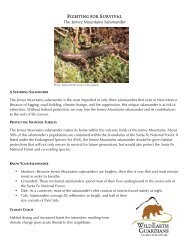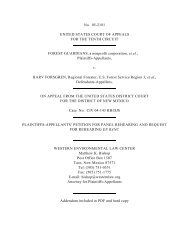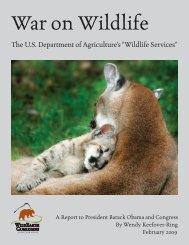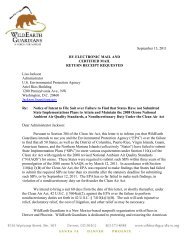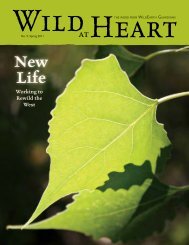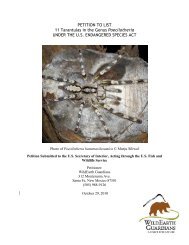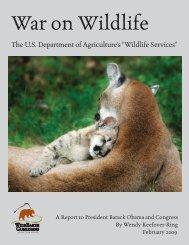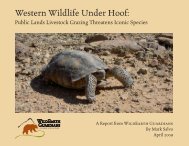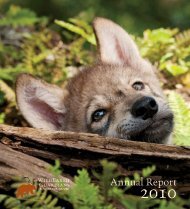here - WildEarth Guardians
here - WildEarth Guardians
here - WildEarth Guardians
You also want an ePaper? Increase the reach of your titles
YUMPU automatically turns print PDFs into web optimized ePapers that Google loves.
Secrets of the sagebrush sea<br />
Mark Salvo<br />
Washington Dept.<br />
photos.com fish & wildlife<br />
idaho fish & game<br />
Animals such as<br />
pronghorn and<br />
pygmy rabbits<br />
depend on the<br />
Sagebrush Sea<br />
for survival.<br />
In the sagebrush lands of the West… the natural landscape is eloquent of the<br />
interplay of forces that have created it. It is spread before us like the pages of an<br />
open book in which we can read why the land is what it is and why we should<br />
preserve its integrity. But the pages lie unread.<br />
— Ra c h e l Ca r s o n, Si l e n t Sp r i n g, 1962<br />
The Sagebrush Sea, scientifically known as<br />
“sagebrush steppe,” is a vast, beautiful<br />
and diverse landscape. The Sagebrush Sea is<br />
expansive country—“open space” prized by so<br />
many Americans. The landscape features lakes,<br />
rivers, streams, springs, wetlands, hot springs, salt<br />
flats, dunes, volcanic rock formations and mountain<br />
ranges. Sadly, many Americans are unaware<br />
of the Sagebrush Sea and the rich tapestry of life<br />
it supports.<br />
The Sagebrush Sea is an ecologically vibrant<br />
ecosystem. While sagebrush dominates the<br />
landscape visually, it grows in delicate balance<br />
with trees, grasses, wildflowers and other shrubs.<br />
Healthy sagebrush steppe is teeming with birds,<br />
large and small mammals, reptiles, amphibians,<br />
crustaceans, insects and fish. Among these are<br />
a suite of species that depend on sagebrush for<br />
their survival, including greater sage-grouse,<br />
Forest Service manages eight percent and<br />
western states own five percent of the Sagebrush<br />
Sea. The rest of sagebrush habitat exists<br />
on private lands.<br />
T<strong>here</strong> is no system as vast as this one in such<br />
free fall.<br />
— Am e r i c a n Bi r d Co n s e rva n c y, 2007<br />
Historically, the Sagebrush Sea covered more<br />
than 150 million acres in western North<br />
America, and was perhaps as large as 243<br />
million acres, spanning parts of what became<br />
sixteen states and three Canadian provinces.<br />
Despite its size, sagebrush steppe is one of the<br />
most endangered landscapes in North America.<br />
The Sagebrush Sea has been reduced in area by<br />
as much as 50 percent since European settlement.<br />
According to one noted researcher, in<br />
only 150-300 years European inhabitants “have<br />
brought about more profound changes” to<br />
sagebrush steppe “than all those of the previous<br />
13,000 years.”<br />
Unfortunately, livestock grazing, gas and<br />
oil development, agricultural conversion, roads,<br />
fences, powerlines and pipelines, off-road vehicles,<br />
urban sprawl, mining, unnatural fire, and<br />
invasive weeds continue to destroy or degrade<br />
much of what remains of the Sagebrush Sea.<br />
Past and current mismanagement of the<br />
Sagebrush Sea has exacted a heavy toll on<br />
resident flora and fauna. More than 350 species<br />
(and as many as 630 species) in the Sagebrush<br />
Sea may be threatened by human activities and<br />
related effects. Approximately 20 percent of<br />
native flora and fauna in the Sagebrush Sea are<br />
imperiled.<br />
8<br />
Gunnison sage-grouse, sage sparrow, Brewer’s<br />
sparrow, sage thrasher, pygmy rabbit, sagebrush<br />
vole, sagebrush lizard, and pronghorn.<br />
Most of the Sagebrush Sea is publicly<br />
owned in the United States. The Bureau of<br />
Land Management controls approximately<br />
half of remaining sagebrush steppe. The U.S.<br />
Legions of leagues (the expression is by no<br />
means too strong) are covered with a wild<br />
growth of sage, that seems designed by Nature<br />
than for nothing else that to feed a certain<br />
variety of the feat<strong>here</strong>d family known as<br />
“sagecocks.”<br />
— Mat t h e w Fi e ld, 1843,<br />
Prairie and Mountain Sketches, 1957



